
|
Sale 81
The Pre-Long Beach Sale
| Lot |
Photo |
Description |
Realized |
Lot 990 |
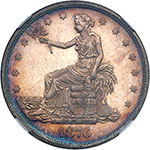 |
1876. NGC graded Proof 64. Lovely blue and golden toning. Only 1,150 struck. A gorgeous Trade Dollar with all the qualifications for this desirable Proof 64 grade. The highly lustrous surfaces exhibit mingled medium toning. Nicely struck as well which is expected on a Proof Trade Dollar, indeed fully so, with merit sufficient to mention here. Pop 43; 24 finer at NGC.
Estimated Value $3,500 - 4,000.
View details and enlarged photos
| Unsold |
Lot 991 |
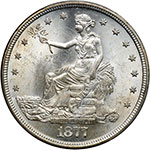 |
1877-S. PCGS graded MS-65. Bright white frost. Well struck and lustrous with exceptional surfaces, grand eye-appeal, and refreshing originality. Unlike the general run of Trade Dollars of this caliber which tended to be baggy and the strike uneven, the strike on this shimmering 1877-S is thoroughly convincing in all places, even where some weakness is usually found at Liberty�s head and the eagle�s legs. Full cartwheel spin makes the luster even more impressive.
According to Neil Carothers, pp.275-6, "By the definition of fractional currency in the first chapter the trade dollar and the standard silver dollar are excluded from the category of fractional silver coins. The history of these two coins in the years after 1873 might well be omitted, were it not for the fact that legislation made these two coins hybrids, neither standard money nor yet subsidiary, but invested with the qualities of both types of money. The history of the two coins is a part of the record of our subsidiary coins.
"It will be recalled that the trade dollar was created by the law of 1873 ostensibly as a convenient coin for trade with the Orient. [Deputy Controller of the Currency John Jay] Knox had in his original bill proposed to make the standard silver dollar subsidiary. When the critics objected, Knox dropped the silver dollar entirely and in his report suggested the possibility of a trade dollar, a coin recommended by Linderman as a substitute for the Mexican dollars used in payments to China. The trade coin section was interpolated into the bill more than two years later, just before the measure was passed, in response to pressure by the silver interests.
"The piece was to weigh 420 grains, 9/10 fine, so that it would have a pure silver content of 378 grains, about 2 per cent above the amount in the standard dollar. It was to have free coinage, in the sense that any one could present bullion to the mint for conversion into trade dollars. Provision was made for a coinage charge equal to the costs of minting. The coin was made legal tender in payments to $5." Pop 27; 8 finer, 1 in 65+, 6 in 66, 1 in 67. (PCGS # 7046) .
Estimated Value $8,500 - 9,000.
View details and enlarged photos
Check results on similar lots
| Unsold |
Lot 992 |
 |
1877-S. NGC graded MS-65. Lightly toned on both sides. A radiant gem of the kind of quality one likes to describe for bidders of this actively collected design. Trade Dollars were minted for only 21 years, 1873 to 1883 to be exact. The business strikes vary from being satin-like to somewhat prooflike. This well struck specimen has some cartwheel spin to the luster which blends effortlessly with pale neutral gray toned highlights on the frosted surfaces. Struck with systematic care throughout including all stars, Liberty�s hair and coronet, the drapery folds and sheaf of wheat on which her arm rests (wouldn�t that itch something awful?); while on the reverse, the eagle gives a nice account of itself. There are full claws, full chest plumage, and crisply defined wing and neck feathers. 1870s San Francisco Mint production at its finest!
Read what America's premier 20th century coin curmudgeon, Walter Breen, had to say in his opening remarks about the Trade Dollar invading the lives of an unsuspecting public:
"The issue of this coin was an expensive mistake -- its motivation mere greed, its design a triumph of dullness, its domestic circulation and legal-tender status a disastrous provision of law leading only to ghastly abuses, its repudiation a source of hardship for Pennsylvania coal miners and other laborers held in virtual peonage by company stores, its recall a long overdue but very mixed blessing, and its collection a source of decades of frustration."
Now, one may argue Breen's point about the Trade Dollar design being a triumph of dullness. William Barber, the coin�s designer, produced a very concise and respectable depiction of Lady Liberty. His eagle, unembellished with the standard (some might say silly) Union shield, he used a second time when the bonehead 20 Cent piece was authorized by the same fine cigar-puffing Congresscritters two years after the Trade Dollar premiered. Compare the Trade Dollar�s so-called dullness to our lovely Susan B. Anthony and Ike Dollars, or some of the nondescript Commemorative coins whose artists must have been trying to out-compete their predecessor�s level of banality. That said, does not such an opening Breen paragraph whet your appetite to learn more about the United States Trade Dollar's remarkable story? We haven't the space to fill in the details further here, but if this has piqued your curiosity, why not pick up a copy of his mammoth Encyclopedia of US and Colonial Coins and read it through. He has much more to say about these utilitarian coins. Pop 28; 6 finer, 4 in 66, 1 in 66 Star, 1 in 67.
Estimated Value $8,000 - 8,500.
View details and enlarged photos
| Unsold |
Lot 993 |
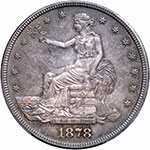 |
1878-S. PCGS graded MS-65. This gem specimen exhibits a beautiful blending of violet and electric blue iridescense on both sides. With a sizeable original mintage of 4.1 million coins, the 1878-S is among the more frequently encountered Trade Dollars in today's market, but mainly in grades up to Mint State 63 or so. The present Gem MS65, however, is a coin whose existence clearly defines what a proper Gem should look like; it is nearly rare for a business strike silver coin of this size to have survived with such attractive surfaces. Soft satin-like fields careening with lustrous antique silver toning. Nicely struck with just outstanding detail at the stars and legends, Liberty and eagle. Obviously this piece was selected with great care. We consider it to be a premium value example among 1878-S Trade Dollars and anticipate that it will attract a lot of attention from collectors who are seeking a very special example. Pop 20; 29 finer (PCGS # 7048) .
Estimated Value $8,000 - 8,500.
View details and enlarged photos
Check results on similar lots
| Unsold |
Lot 994 |
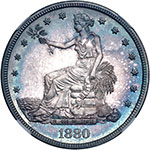 |
1880. NGC graded Proof 66. Nice light blue toning. Only 1,987 struck. A more than moderately bright and lively Gem Proof with strong mirror luster in the field and a confident, no-compromises strike at Liberty, the eagle, and the date and legends. Everything you would want from the grade, and probably then some.
The Trade dollars were caused problems in domestic circulation. Because they were not legal tender. their value as silver bullion was below their face value. After circulation mintage ceased in 1878, Proofs only were still made for collectors in 1879-83. Although Proof mintage ceased after 1883, Congress did not repeal the law authorizing Trade dollars until February 1887. No reason for the delay seems to be given for this in the archival records. Pop 42; 22 finer, 2 in 66 Star, 2 in 66+, 17 in 67, 1 in 68.
Estimated Value $8,500 - 9,000.
View details and enlarged photos
| Unsold |
Lot 995 |
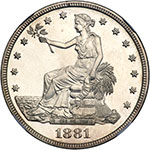 |
1881. NGC graded Proof 66. Fully white with a cameo effect. Only 960 struck. A vibrant and smooth-as-glass surface makes this Gem Proof 1881 Trade Dollar a lustrous coin indeed. It has a distinct transition from smooth reflection in the field to the sharp almost satin-like devices that rise majestically from the surface. The contact from the dies is complete, as one might expect. Proof Trade Dollars, like most all US Proof coins struck in the 19th century, were made using a special coinage press. By 1881, according to sources, the Mint had them made on a hydraulic press used to strike Mint medals. To strike Proof collector coins on it, each planchet was given two blows by the dies. (In everyday production coins, by contrast, the coins were struck on the steam-operated (and later, electric-motor) high-speed coining presses. They received only one blow from the dies. This means there is sharp detail everywhere on this 1881 Proof, as evidenced by complete stars and full features on Liberty, the crisp square-topped lettering in the reverse legends, as well as needle-point accuracy in the eagle�s talons, feathers, and eye and beak. Today, Gem Proof 66 examples are quite scarce. The surfaces testify to careful preservation, showing no indications of mishandling of any kind. Pop 19; 8 finer in 67.
Note: By the later-1870s, it became evident to everyone except congressmen that America's Trade Dollar experiment was a dismal failure. Many of these non-monetized coins remained at home instead of circulating as trade coins in the Orient, which had been their primary purpose. This caused untold grief to workers and small businessmen. Speculators could buy them up in quantity at 85 cents apiece and sell them to payroll departments in major companies, which put them in the employees� pay envelopes at "full value" of $1! Eventually, the wheels of congress began turning: after 1878, only Proofs were struck, exclusively for collectors. And finally, in 1887, long after the last Proof 1883 was shipped to its collector-buyer, our "Coconuts on the Hill" (as H. L. Mencken called these erstwhile DC. gentlemen) put an end to the experiment.
Estimated Value $8,500 - 9,000.
View details and enlarged photos
| Unsold |
|
|